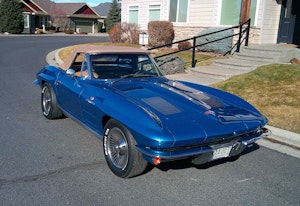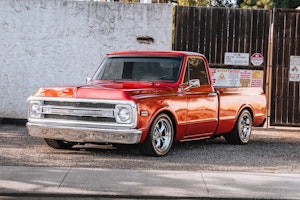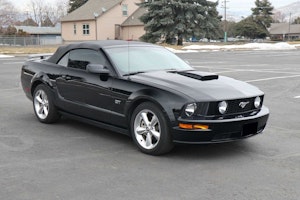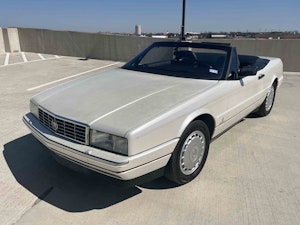Media | Articles
Coulda Had a V-12: Here Are 10 of the Most Memorable
Thanks to recent news from Aston Martin and Ferrari, the V-12 engine layout thankfully remains in production and continues to find a home in new vehicles. It’s great news, and easily put into words. Less easily described, though, is the sound of a V-12 engine—you truly need to hear one to appreciate their symphony.
Those sonorous notes, along with the silky smooth power delivery that comes with them have graced the automotive landscape for decades. In celebration of the V-12’s continued presence, we took a look back into the V-12 engine’s storied history across multiple brands to pick some of our favorites.
Packard Twelve

The Packard Twelve started life as the Packard “Twin Six,” but the second generation of Packard V-12 (1933-39) and was known for a body design worthy of a V-12 engine. Packard’s iconic grille was paired with some of the most famous coachbuilders of the era, including LeBaron and Dietrich. The Packard Twelve was indeed the flagship of Packard line, with the Super Eight, Eight, and “Junior” models like the One-Twenty, Six, and One-Ten slotting below. They were fine models with perfectly acceptable engines, but the Twelve was the one that stood out.
2008 Audi Q7 V-12 TDI

You weren’t ready for this one, were you? But it’s true, as the Volkswagen Group made a V-12 engine for the flagship Q7 utility vehicle. This was before Dieselgate came to fruition, so this turbocharged, direct injected, V-12 diesel had the potential for success.
Audi’s oil burning V-12 was used on this single vehicle from 2008-12, sporting 493 horsepower and a whopping 738 lb-ft of turbodiesel torque. While this particular Q7 never made it to the U.S., it would absolutely be one of the most amazing diesel vehicles in America, when they are legal to import in 2033, that is.
Marketplace
Buy and sell classics with confidence
Jaguar V-12

While an inline-six rests beneath the bonnet of many iconic Jaguars, it was only natural for larger, later model Jags to utilize the relaxed cadence of its V-12 motor in 5.3- or 6.0-liter displacements. Luxury cars were getting bigger and bolder, and doubling the cylinder count certainly helped with that transition.
Jag even developed a 7.0-liter example used in motorsport, but Jaguar’s V-12 was primarily notable as a top-tier luxury car powerplant during the Malaise Era, thanks to the addition of fuel injection and a High Efficiency (HE) combustion design in 1981. This smooth, relaxed engine was the perfect dance partner to a cabin fitted with decadent leather and burl wood, and its demise in 1997 was the end of an era for British motoring.
Lincoln-Zephyr V-12

Like so many other components found in Lincoln vehicles, the flathead V-12 found in 1932 model Lincolns and Zephyrs was heavily based on parent company Ford’s flathead V-8. The motor wasn’t without its flaws however, mostly present in its PCV, oiling and cooling systems. Those issues were addressed over time, however, and Lincoln’s V-12 ultimately became part of the brand’s success: Take something from Ford, modify the heck out of it, and turn it into something worthy of a luxury vehicle.
Ferrari Colombo V-12

Named after its creator, Gioacchino Colombo, this Ferrari V-12 powered some of the most famous, desirable and valuable vehicles to wear Ferrari’s prancing horse emblem. The sheer volume of changes this motor underwent over the course of its 41-year production run is impossible to cover for this list.
No matter, though: Every iteration of this all-aluminum masterpiece delivered the feel and sound of exotic performance befitting a Ferrari, from its placement in the original 1947 Ferrari 125 S, to icons like the 1962 Ferrari 250 GTO, and delightful touring cars like the final Ferrari 412i from 1988.
BMW M70

While BMW’s flagship V-12 came in four variations over the course of several decades. Perhaps the most appealing example is the M70 design that powered the E32-generation 7-series and E31 8-series. Be it a BMW 750i or 750iL, you were guaranteed one of the best performing luxury sedans on the planet. And the 850i, 850Ci, and 850CSi were grand touring coupes of the highest order, especially when optioned with a six-speed manual transmission.
But the real reason why the M70 V-12 from BMW was so special is its legacy with the McLaren F1. Its stunning 618 horsepower helped propel the F1 to an insane top speed of 240.1 mph in 1998, thanks to four-valves per cylinder, variable valve timing, and a surprising lack of forced induction. Ah, if only modern hypercars could take a page from BMW’s M70 masterpiece and ditch the turbochargers!
Cadillac V-12

Here’s an awkward twist to the overall theme of this story: While most auto manufacturers had a V-12 as their flagship, top-of-the-line, first class powerplant, this doesn’t apply to Cadillac. Their V-12 was actually one of their V-16 engines with four cylinders lopped off.
The V-12 Caddy was made from 1930-37, and “only” made 135 horsepower relative to the V-16’s rating of 165. While both were premium offerings with features like overhead valves and hidden wiring/plumbing, this V-12 rightly plays second fiddle to the Cadillac V-16.
Toyota GZ

While Japan is better known for engines with fewer pistons, the Toyota Century and its V-12 engine are the crown jewels for an entire nation. Toyota had premium-car intentions for decades, but no other brand in Japan had the nerve to equip a vehicle with a V-12 engine. Toyota did just that for their flagship Century luxury sedan in 1997. In doing so, the V-12 (codenamed 1GZ-FE) soldiered on for another 20 years, ensuring Toyota’s place in luxury car history.
Lamborghini V-12

Ferrari was slow to full embrace dual overhead camshafts for their V-12, but Lamborghini (as was their wont) chose a different path, going all in on the four-camshaft phenomenon with the V-12 in their first car, the 350 GT. The same engine family powered Lambos for decades, including the Miura and Countach, and ending its reign with the 2010 Murciélago. While modern Lambos under the watchful eye of Audi are clearly better performers with modern V-12 engines, their improvements only serve to enhance the original’s mystique. And perhaps it proves that all supercars need twelve cylinder engines, otherwise perhaps they aren’t actually that super at all?
Mercedes M275

While there are four generations of Mercedes-Benz V-12 opulence, the M275 was both twin turbocharged and impressive enough to remain in production for the latest Pagani hypercars. That’s right, even the new Pagani Utopia uses an M275 (technically an M158 derivation) to achieve forward thrust with 754 horsepower, with a manual transmission to boot.
But the M275 V-12’s zenith doesn’t necessarily point solely to the crème de la crème Pagani—there were too many fantastic automobiles that utilized this engine. The list includes Maybach luxury sedans, S/SL/CL “600” class luxury cars and their AMG tuned “65” series counterparts, the radical SL65 AMG Black Series, and even the outlandish Maybach Excelero sports car. Their torque output was legendary and impossible to match, and it’s one of the few engines that can provide EV-like thrust at low speeds with Lamborghini-like top end acceleration.
Perhaps we saved the best for last, as this motor could be considered a gold standard for which all modern luxury cars are judged by. Mercedes has made a replacement for this motor (M279), but it doesn’t do anything to tarnish the twin turbo M275’s performance potential. We can thank Pagani for that, or perhaps we should credit Mercedes for keeping the V-12’s flame alive in more ways than any other automaker possibly could.
***
Check out the Hagerty Media homepage so you don’t miss a single story, or better yet, bookmark it. To get our best stories delivered right to your inbox, subscribe to our newsletters.






















worked @ a foreign car salvage yard in Va in the late 70’s– Had a Muira eng on a stand in the office for years.
Whenever I think of a V-12 engine the first cars that come to mind are Italian exotics, specifically Ferrari.
The Lincoln V12 shown is a completely different engine than the later Zephyr unit described. The model shown was used in the KB and K Lincolns from 1932 to 1939. It had several design iterations during that time, starting out as a fork and blade connecting rod design and switching to the more conventional connecting rod in ’35 I think it was. Horsepower was rated at 150.
Thanks for that information. The Zephyr motor was monobloc, was it not?
Thank you for that. I had thought the V-12 in the big Full Classic ( K and KB) Lincolns was very different engine than the Ford flat head derived V-12 in the Zephyrs and the Continentals. From what I have read the latter V-12 was not a durable engine at all. Especially if not driven at high way speeds a lot. They sometimes needed an overhaul at 30K miles. The later were very underpowered. If I am wrong about this please reply.
The BMW V12 in the McLaren F1 is my favorite. Lamborghini and Ferrari have had many legendary V12’s that look and sound fantastic.
1998 BMW 750IL E38. 200K and still going strong. About as bulletproof as you can get for a BMW.
Please spell out diesel with a capitol D. The surname of the inventor is surly due this respect.
You didn’t even do that in your own comment… If you research it, the diesel engine is named for Rudolf Diesel, but not named the diesel engine by Rudolf himself. Hence, no capitalization when refer to the engine.
“Ah, if only modern hypercars could take a page from BMW’s M70 masterpiece and ditch the turbochargers!”
Did you forget about the Ferrari 812 and now the 12Cilindri?
https://www.hagerty.com/media/news/ferrari-12cilindri-twins-replace-the-812-superfast/
Not really, as those are touring cars and not hypercars. No disrespect to those fine machines, but they aren’t modern interpretations of the McLaren F1.
What would happen if you put 2 v12 s together and have a v24?
You would have a Fiat AS.6. Other V-24s were made by Detroit Diesel and Jenbacher (among others), and most were paired V-12s.
I’ve seen many early Cadillac V-12’s and V-16’s with overhead valves. They were true works of art and the overhead valves put them years ahead of their competitors. The entire engine block and heads were porcelainized like a bathtub with most other parts all chromed. I saw a GM documentary once and they were hand built. Balanced parts and hand fitted. I guess with the depression they just cost too much to make because I think starting in 1936 Caddy made 12’s and 16’s but they were flatheads.
I see alot of comments about the Packard built Merlin. What will never cease to amaze me Packard made some of the most sophisticated engines during WW2 yet when the war ended they continued to make the outdated engines they produced before the war. They could have easily downsized the Merlin make an 8 cylinder version and buried the competition. Everybody had an OHV by 1954 except for Chevy, Plymouth, Nash, Pontiac and Packard. The difference was Packard was a luxury car maker and all their competitors had one.
The Chevy “Stovebolt” six was OHV.
They didn’t have rights to the Merlin – it was being made under license. The Merlin was also a very expensive engine to build. The cylinder banks and block were separate components. What made Ford the king of the V-8 was that the company was able to cast the block and cylinders in one piece, which made it relatively cheap. Time between overhauls for a Merlin was about 120 hours; that’s woefully inadequate for an auto engine.
Immediately after the war, cars were scarce and demand was high. The manufacturers could sell anything they could make. After merging with Studebaker in 1953, Packard moved to OHV V-8s right along with Ford and Chevrolet.
Love my V-12
2014 (Last Year MFG) Mercedes-Benz CL65 AMG
Thank you Sanjeev. My fav in this difficult and fine field?
The 4 cam Miura engine screaming just 6 inches from your head. There’s nothing like it!
All of the V12s listed were / are volume produced. And all have a distinctive exhaust note, from subdued virtual silence to snarling wild animal. But one V12 that did not make your list was the greatest sounding engine of all time: The 3.0litre Georges Martin designed Matra MS73. For motorheads to hear it’s shreik is the call of Homer’s Sirens.
The luxury Lincoln V-12 was introduced in 1932 as the model KB with 448 CID, 150 HP, and 65-degree bank angle.
The Lincoln Zephyr (the low-priced Lincoln) was introduced in 1936 with a displacement of 267 cubic inches, 110 HP, and a bank angle of 75 degrees. Its design was based on the Ford flathead V8 with a single piece block casting.
Wouldn’t the 2008-2012 Audi diesel be part of the dieselgate scandal? The model years fit.
It never came to America and it had urea technology to reduce emissions, if I recall my research correctly.
None of those V12’s would survive one tenth of Irv’s Volvo 1800 four cylinder with 3,200,000 miles. I have turned down offers of several 12 cylinder XJ and XK’s I wouldn’t take one for free with a V12. I have had an 88 Jag sovereign, ( page 144 of the Worst Cars Ever built ) and its 4 litre fuel injected 6 was wonderful, but sadly only one out of four door handles actually worked. 7 kms of wiring was the problem, not lack of cylinders. I loved my beautiful burgundy 66 E-type coupe but got tired of scrunching my neck down, so I drive my Austin Healey 3000 Mark II and III’s with more comfort, timeless beauty, and with the taller rear ends, no problem doing 140 MPH. Why would I want a twelve when the sixes are so bullet proof ?
I’m with you. As a lifelong autoholic friend who’s owned inline 6s, straight 8s, vintage V-12s sums the latter, “too much of a good thing.” Inline 6s and 8s are the only automotive engines with natural inherent balance.
Less to go wrong, plenty smooth. All anyone needs.